The most stressful part of camping with a baby is sleeping in a tent. If you are worried about your baby getting cold in the tent, which sleeping bag to use, how to get your baby to sleep, or anything else related to sleeping in a tent with a baby, here’s what you need to know.
1. Choose a Bigger Tent
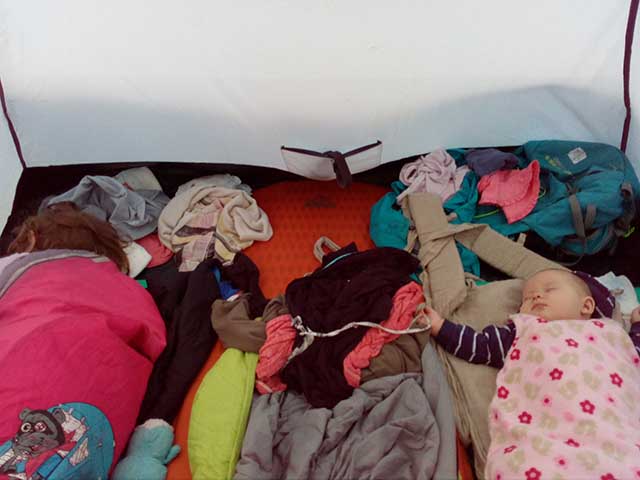
It was a bit crowded in this 3-person tent!
Because of all the extra space your baby requires (so you don’t roll over on her and have room for all her extra stuff), you may want a bigger tent. Two adults plus a baby will likely need a tent for at least 4 or 5 people – not just three.
Another benefit of a larger tent is that you will probably get more headroom. This extra headroom is very useful when you’ve got to sit up to breastfeed in the middle of the night. Or when you are trying to put a sleeping baby in the tent without waking her.
If you want to use a portable playpen or crib in the tent, you’ll probably need a cabin-type tent because they have vertical walls which give you much more interior space.
Got More than One Kid? Consider Using Two Tents
I have an older daughter and didn’t want her getting woken up by the baby at night. So, our solution was to bring two tents. I stayed in one tent with the baby and my daughter and husband stayed in the other tent. Having an extra tent also helps keep things more organized.
2. Get Your Baby a Sleeping Bag
Don’t try to co-sleep with your baby in the same sleeping bag (here’s why). You and your baby will be more comfortable in your own sleeping bags.
Currently, there are only two brands that make baby sleeping bags for camping in the USA. In warmer weather, you can put your baby in comfy jammies and a sleep sack. But, in colder temperatures, you really need a proper sleeping bag for your baby.
Read my reviews of the best baby sleeping bags for camping here.
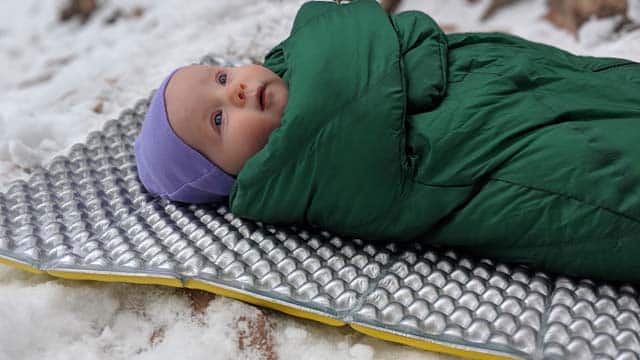
Morrison is one of the few brands which makes camping sleeping bags for babies. Read my review here.
3. Get a Sleeping Pad for Your Baby
I’m a minimalist camper and usually carry all the gear to camp (aka backpacking), so my baby mostly just sleeps on her own sleeping pad. It’s important that the sleeping pad is firm and has a higher R-value so it insulates against the ground.
Do NOT use an inflatable air mattress! Babies should sleep on a hard surface. Plus, inflatable air mattresses are heat sinks and thus not warm. It is safer to use a foam or self-inflating mattress instead.
Pro Tip: Put a fleece jacket over the top of the sleeping pad (zipper side down). This creates a large, soft surface for your baby’s head. I also use wrap a few diapers in a towel for her to use as a pillow.
Read: Best Camping Sleeping Pads for Babies
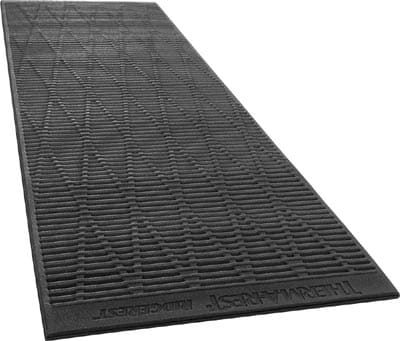
This closed-cell mat has an R-value of 2.6. Fold it in half to get an R-value of 5.2. It is insanely affordable. Buy it here
Making sure your baby stays on the sleeping pad:
If your baby rolls off the sleeping pad, the ground will quickly suck their body heat and cause them to get cold. I put a full backpack alongside my baby so she can’t roll off the pad at night. I know of other campers who bring a full body pillow to put next to the pad.
Another option is to simply have your baby sleep between you and your partner. This keeps them in place. The downside is that both of you end up getting kicked in the face :p
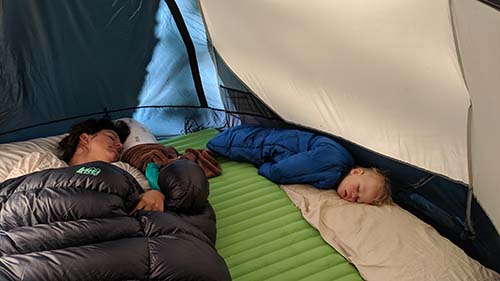
Your baby will inevitably roll off their pad! Put something next to the sleeping pad so your child doesn’t end up on the cold ground. Image from Morrison Sleeping Bags.
4. Consider a Portable Baby Bed or Cot
Once your baby starts crawling or walking, you’ve got to worry about them getting out of bed in the middle of the night. One solution is to bring a portable baby bed for them. Or, if your tent is big enough, you can put a portable playpen in the tent. A baby bed is also good if you are worried about rolling over your baby at night.
Note that you may still need to use a sleeping pad. Cold air will circulate underneath the playpen or portable crib, drawing heat away from your body. So, put a sleeping pad in the play pen under your baby. Alternatively, use a few thick blankets to line the playpen.
Read: Best portable baby beds for camping.
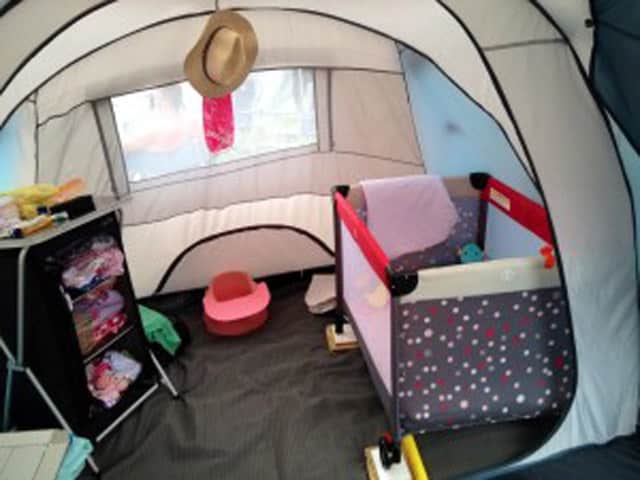
Travel Mad Mum uses this awesome setup (shown above) when camping with her baby. At night, the baby wore a vest, sleep suit, sleep sack, hat, mittens, and a light blanket on top. The Pack n Play is super-useful for baby to play in during the day too.
5. Invest in Good Pajamas
The key to keeping your baby warm and comfortable while sleeping is to put your baby in pajamas made from breathable materials. Merino wool is a great material because it will insulate even when wet. If you are on a budget, fleece is a good alternative.
Read: Best camping pajamas for kids and babies
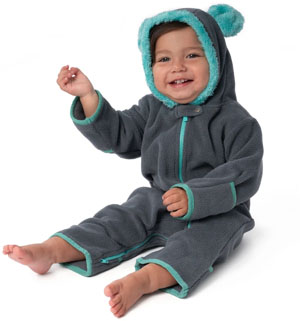
Baby DeeDee makes these cute fleece jammies which are great for camping (available in sizes from 3 to 24 months)
Pro Tip: Resist the urge to over-bundle your baby because you are worried they will get cold. This will cause your baby to SWEAT. Then your baby will be WET. And then you will really worry that she is cold and won’t know whether to remove layers to stop the sweating or put on more layers to protect against evaporative cooling (again, speaking from experience).
5. Get a Lamp with a Red Light Setting
Your baby needs to be fed/changed/soothed in the middle of the night? You’ll need to turn on a lamp to see in the tent… And good luck getting your baby back to sleep with the bright light on!
A soluiton is to get a lamp with a red light setting. The red light gives you visibility without blinding your baby or waking up anyone in your tent.
You can even leave the red light setting on as a nightlight.
6. Have Backups in Case of Accidents
Diaper explosions, projectile vomiting, spilled bottles… These are never fun, but could cause a serious problem if they occur while camping. If your baby’s sleeping bag or pajamas end up wet, they won’t have a way to stay warm. This is why you need to bring backups.
Backup pjs is fairly easy. But you probably don’t want to buy a backup sleeping bag. Instead, here are two solutions:
- Diaper Leak Catcher: Put a waterproof pad inside the sleeping bag under your baby. This will catch most leaks. The PJs will still need to be changed but at least the sleeping bag stays clean. Alternatively, you can spread out several diapers underneath your baby to catch any leaks.
- Adult down jacket = backup sleeping bag: As AniaLife talks about in her great post about traveling with babies, you can wrap a baby in an adult down jackets to use as a sleeping bag.
7. Wear a Down Jacket if Breastfeeding in the Tent
The main issue with breastfeeding in a tent is that mom has to get at least her torso out of the sleeping bag. This means that her upper body can get very cold.
A good solution from Tanya of Rockies Family Adventures is for mom to wear a down jacket while sleeping. Then you can keep your upper body out of the sleeping bag without it getting cold. Just unzip the jacket when it’s time to feed.
Here’s a picture (below) of Tanya and her baby all bundled up and ready for bed!
8. Reserve the most isolated campsite
I get very stressed about annoying neighbors while camping. So, when making reservations with a campground, I always tell them that we are coming with a baby and ask for the most remote campsite. Then it isn’t such a big deal if my baby cries in the middle of the night.
Also read: Is it rude to camp with a baby?
9. Getting Your Baby to Fall Asleep
When my daughter was a newborn, she actually slept better in the tent than at home in her crib. I guess all the fresh air tired her out. But, as she got older, getting her to fall asleep became harder. She was too excited to nap and wanted to “escape” the tent at night to play some more. I did learn some tricks to make sleep time easier with a baby while camping. Here they are.
- Put on PJs early: You don’t want to wake a sleeping baby to put pajamas on. So make sure you put PJs on before bedtime. Then your baby will already be dressed for bed if she crashes early.
- Put your baby in the sleeping bag early: I even take things a step further and make my daughter get in her sleeping bag before bedtime. When she falls asleep in my arms in front of the campfire, all I have to do is transfer her to the tent.
- Make sure your baby has plenty of time to crawl/run: Try not to keep your baby in the carrier or stroller too much during the day. Then they will get tired out and (hopefully) sleep better. Bring a rain suit or gigantic picnic blanket so she can be on the ground without getting wet or dirty.
- Don’t stress too much about bedtime schedules: While it’s nice to maintain your normal schedule as much as possible, don’t obsess over it. Naps are bound to happen at different times, which in turn means your child might end up going to sleep at night at a different time.
10. Keeping a Baby from “Escaping”
A very legit concern about camping with crawling or walking babies is whether they will wander off in the middle of the night. Here are some solutions that I’ve gotten from other parents.
- Do the zips up high where your baby can’t reach them.
- Consider using a portable playpen or crib in the tent; one which is too high for them to crawl out of on their own.
- Sleep across the doorway. Then your baby will have to crawl over you to get out at night.
*Do NOT lock the tent door in anyway. If you need to escape quickly, you won’t be able to get out.
Have you gone camping with a baby? Let us know your sleep advice in the comments below.


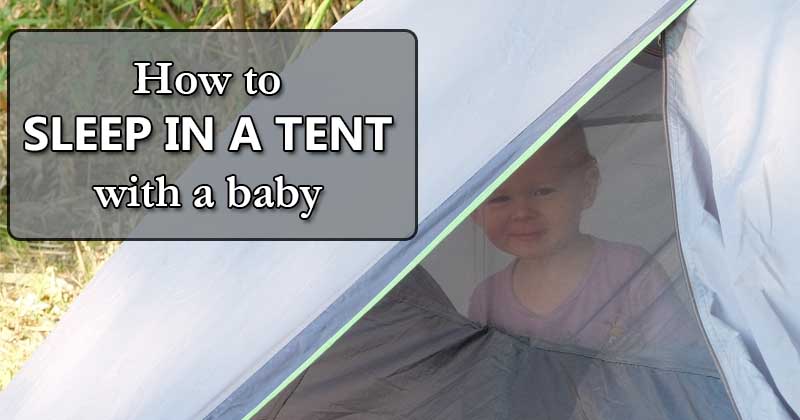
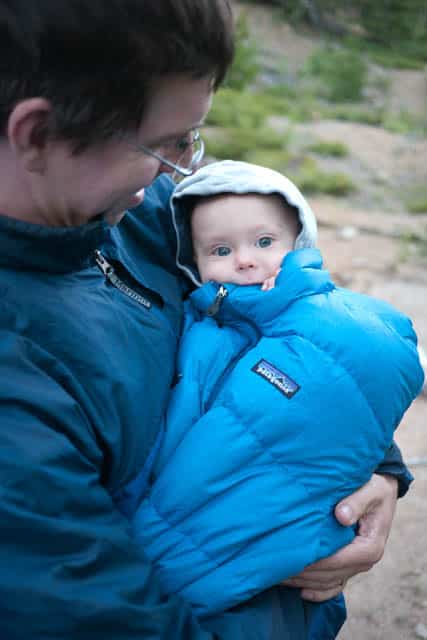
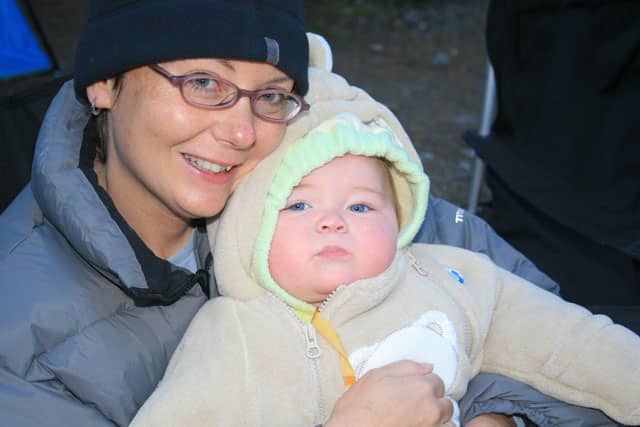
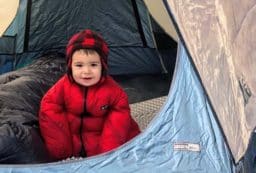
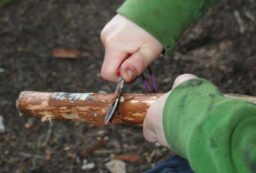
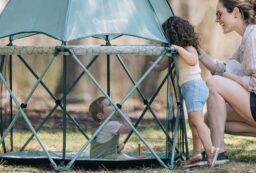







Post your comments